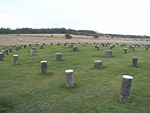Amesbury Abbey
10th-century establishments in England1177 disestablishments in England979 establishmentsAmesbury AbbeyAnglo-Saxon monastic houses ... and 6 more
Benedictine monasteries in EnglandBenedictine nunneries in EnglandChristian monasteries disestablished in the 12th centuryChristian monasteries established in the 10th centuryMonasteries in WiltshireOrder of Fontevraud
Amesbury Abbey was a Benedictine abbey of women at Amesbury in Wiltshire, England, founded by Queen Ælfthryth in about the year 979 on what may have been the site of an earlier monastery. The abbey was dissolved in 1177 by Henry II, who founded in its place a house of the Order of Fontevraud, known as Amesbury Priory. The name Amesbury Abbey is now used by a nearby Grade I listed country house built in the 1830s, currently a nursing home.
Excerpt from the Wikipedia article Amesbury Abbey (License: CC BY-SA 3.0, Authors).Amesbury Abbey
Church Street,
Geographical coordinates (GPS) Address Nearby Places Show on map
Geographical coordinates (GPS)
| Latitude | Longitude |
|---|---|
| N 51.1719 ° | E -1.7843 ° |
Address
St Mary & St Melor
Church Street
SP4 7ES , Amesbury
England, United Kingdom
Open on Google Maps









